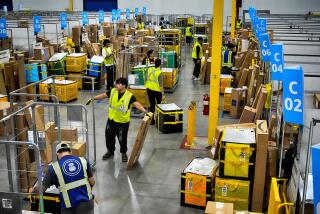0.5% Economic Index Gain Points to Strong 2nd Half
WASHINGTON â The governmentâs gauge of future business activity rose a healthy 0.5% during March, pointing to an economic resurgence in the second half of the year, the Commerce Department reported Tuesday.
Falling interest rates, declining oil prices and minimal inflation should combine to stimulate the economy, experts believe. A boom already is under way in housing and the Commerce Department said that sales of single-family homes set a record last month.
The index of leading economic indicators, compiled from a variety of measures such as stock prices and new orders for consumer goods, is considered a reliable guide to economic activity during the next several months.
The March gain of 0.5% followed a substantial increase of 0.9% during February. The pace has accelerated since January, when the index was unchanged.
âI think what you are seeing is the economy shifting gears, making the transition from slow growth to faster growth,â said Leslie M. Alperstein, president of Washing ton Analysis Corp., an affiliate of the First Manhattan Co. brokerage firm. âAll logic suggests future growth will be faster.â
The U.S. Chamber of Commerce expects a surge of growth in the second half of the year, with the national output of goods and services expanding at an annual rate of 6%, far above the first-quarter growth rate of 3.2%. âWeâre pretty excited about this year,â said Ronald Utt, associate chief economist.
The benefits of falling oil prices will be felt in the second half of the year, he noted. âThe pains are immediate,â Utt said, as oil businesses cancel drilling plans, stop orders for pipe and equipment and begin laying off workers.
More Spending Money
But the broader benefits take longer to work through the economy as each corporation and household gets more spending money while energy costs gradually decline.
Another strong stimulus to the economy is coming from the housing market, which has âjust gone absolutely berserk,â Utt noted.
Sales of new single-family homes soared 27.5% during March, hitting an annual rate of 903,000 in March, the hottest sales pace since the government began keeping such records in 1962. Actual sales totaled 87,000 homes, up from 58,000 in the previous month.
The demand for housing is so strong that the inventory of unsold homes has been cut to a four-month supply, the lowest level since July, 1971.
The median cost of new homes sold in March was $88,300--half cost more and half less than this price.
Other Signs Corroborated
The climb in the leading indicators âcorroborates other signs that the economy will hand in a better performance in the second half,â said Jerry Jasinowski, executive vice president and chief economist of the National Assn. of Manufacturers.
âThe fact that new orders for consumer goods and capital equipment went down suggests that the economy will continue to be weak in the second quarter and that higher growth rates will not emerge until later in the year,â he said.
The components of the index that rose last month included stock prices, the money supply, the number of building permits, the length of the average workweek and the volume of loans.
However, new orders for consumer goods and materials declined, as did contracts for industrial equipment. In addition, initial claims for unemployment rose.
Led by Housing
Housing is leading the recovery from the sluggish growth of the last year, said John Hagens, vice president of Chase Econometrics of Bala Cynwyd, Pa., a forecasting and consulting firm.
But the housing boom will taper off when the growing demand is satisfied. âThere are just so many buyers for housing, and they have gotten in early,â Hagens said.
After housing slows down, the output of U.S. goods destined for export will pick up the slack in the economy, he said. The dollar has fallen in relation to other currencies, making American goods cheaper for foreign customers.
The experts now foresee an unusual and welcome combination of events, strong growth and low inflation, for the rest of the year. Inflation is expected to range between 2% and 3% for the year. Prices rose 3.8% during 1985.
More to Read
Inside the business of entertainment
The Wide Shot brings you news, analysis and insights on everything from streaming wars to production â and what it all means for the future.
You may occasionally receive promotional content from the Los Angeles Times.










